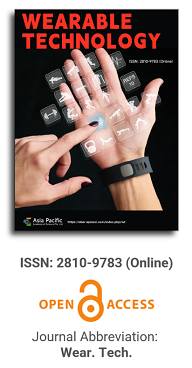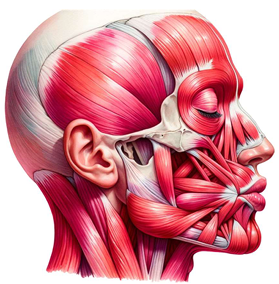

This paper delves deeply into the innovative realm of integrating human emotions with wearable technology. The primary focus is on the conceptualization and development of a kiss transfer device that harnesses the power of wearable technology to bridge the physical gap in human-human interactions. By investigating the intricate nuances of the human-human kissing process, the research seeks to replicate this intimate gesture through a technological medium. The paper not only elaborates on the anatomy, evolution, and hormonal dynamics of kissing but also underscores the transformative potential of wearable technology in capturing and transmitting these intimate moments. This exploration opens up new horizons for long-distance relationships, offering a tangible touchpoint that goes beyond traditional communication methods. Through this pioneering work, the research positions wearable technology as not just a tool for communication but as an extension of our human emotions and expressions.

Ventricular assist device for advanced heart failure
Vol 2, Issue 1, 2021
Download PDF
Abstract
Heart failure (HF) continues to be a highly prevalent disease, affecting 1–2% of the population in developed countries, therefore constitutes a health problem due to its high cost. Despite the progress made in drug treatment and implantation devices, the prognosis is poor. About 5% of patients diagnosed with heart failure are in advanced stage or stage D. Heart transplantation (HT) has become the preferred treatment for this high-risk group in the past 30 years. Unfortunately, in addition to the limitation of the current shortage of donors, there is only a limited number of patients meet the appropriate age and with the absence of comorbidities necessary to access this treatment. Due to this and the long waiting lists worldwide, the development and use of ventricular assist devices (VAD) are increasing. In view of the quality of life of patients with this serious disease, these devices improve the short-term and long-term survival rate and gradually reduce the complication rate. These benefits not only provide a choice for patients waiting for HT, but also give those with reversible contraindications the time and opportunity to become suitable candidates or, if impossible, eventually use it as a target treatment. However, these devices have many limitations: their cost, durability, incidence of complications and their limited application. Technological advances in mitigating complications, increased experience in management centers and their promotion to reduce costs are strategies that will continue to strengthen the use of VAD in patients with advanced heart failure.
Keywords
References
- Ponikowski P, Voors AA, Anker SD, et al. 2016 ESC Guidelines for the diagnosis and treatment of acute and chronic heart failure: The Task Force for the diagnosis and treatment of acute and chronic heart failure of the European Society of Cardiology (ESC). European Journal of Heart Failure; 18: 891–975.
- Yancy CW, Jessup M, Bozkurt B, et al. 2013 ACCF/AHA guideline for the management of heart failure: a report of the American College of Cardiology Foundation/ American Heart Association Task Force on Practice Guidelines. Journal of the American College of Cardiology 2013; 62: E147–E239.
- Metra M, Ponikowski P, Dickstein K, et al. Advanced chronic heart failure: A position statement
- from the study group on advanced heart failure of the Heart Failure Association of the European Society of Cardiology. 2007 European Journal of Heart Failure 2007; 9: 684–694.
- Lund LH, Edwards LB, Kucheryavya, et al. The registry of the international society for heart and lung transplantation: Thirty-second official adult heart transplantation report--2015; Focus theme: Early graft failure. Journal of Heart and Lung Transplantation 2015; 34: 1244–1254.
- Gonzalez Vilchez F, Segovia Cubero J, Almenar L, et al. Spanish heart transplant registry. 26th official report of the working group on heart failure and heart transplantation of the Spanish Society of Cardiology (1984–2014). Revista Española de Cardiología 2015; 68: 1008–1021.
- Gibbon JH Jr. Application of mechanical heart and lung devices in cardiac surgery. Mien Medicine 1954; 37: 171–185.
- Liotta D, Hall CW, Henly WS, et al. Prolonged assisted circulation during and after cardiac or aortic surgery: Prolonged partial left ventricular bypass by means of intracorporeal circulation. American Journal of Cardiology 1963; 12(3): 399–405.
- DeBakey ME. Left ventricular bypass pump for cardiac assistance: Clinical experience. The American Journal of Cardiology 1971; 27(1): 3–11.
- Cooley DA, Liotta D, Hallman GL, et al. Orthotopic cardiac prosthesis for two-staged cardiac replacement. The American Journal of Cardiology 1969; 24(5): 723–730.
- Portner PM, Oyer PE, Pennington DG, et al. Implantable electrical left ventricular assist systems: Bridge to transplantation and future. The Annals of thoracic surgery 1989; 47(1): 142–150.
- Rose EA, Gelijns AC, Moskowitz AJ, et al. Long-term use of a left ventricular assist device for end-stage heart failure. New England Journal of Medicine 2001; 345: 1435–1443.
- Slaughter MS, Rogers JG, Milano CA, et al. Advanced heart failure treated with continuous-flow left ventricular assist device. New England Journal of Medicine 2009; 361(23): 2241–2251.
- Pagani FD, Miller LW, Russell SD, et al. Extended mechanical circulatory support with a continuous-flow rotary left ventricular assist device. Journal of the American College of Cardiology 2009; 54(4): 312–321.
- Sen A, Larson JS, Kashani KB, et al. Mechanical circulatory assist devices: A primer for critical care and emergency physicians. Critical Care 2016; 20: 153.
- Sanchez-Enrique C, Jorde UP, Gonzalez-Castello J. Heart transplant and mechanical circulatory support in patients with advanced heart failure. Revista Española de Cardiología 2017; 70: 371–381.
- Thiele H, Zeymer U, Neumann FJ, et al. Intra-aortic balloon support for myocardial infarction with cardiogenic shock. New England Journal of Medicine 2012; 367: 1287–1296.
- Capoccia M, Bowles CT, Pepper JR, et al. Evidence of clinical efficacy of counter pulsation therapy methods. Heart Failure Review 2015; 20(3): 323–335.
- Khir AW, Price S, Henein MY, et al. Intra-aortic balloon pumping: Effects on left ventricular diastolic function. European Journal of Cardio-thoracic Surgery 2003; 24: 277–282.
- Takayama H, Truby L, Takeda K, et al. Short-term ventricular assist devices: Implantable and percutaneous. Current Surgery Reports 2014; 2: 58.
- Gilani FS, Farooqui S, Doddamani R, et al. Percutaneous mechanical support in cardiogenic shock: A review. Clinical Medicine Insights: Cardiology 2015: 9(S2): 23–28.
- Boudoulas KD, Pederzolli A, Saini U, et al. Comparison of impella and intra-aortic balloon pump in high-risk percutaneous coronary intervention: vascular complications and incidence of bleeding. Acute Cardiac Care 2012; 14(4): 120–124.
- Naidu SS. Novel percutaneous cardiac assist devices: The science of and indications for hemodynamic support. Circulation 2011; 123(5): 533–543.
- Sidebotham D, McGeorge A, McGuinness S, et al. Extracorporeal membrane oxygenation for treating severe cardiac and respiratory failure in adults: Part 2-technical considerations. Journal of Cardiothoracic Vascular Anesthesia 2010; 24(1): 164–172.
- Cove ME, MacLaren G. Clinical review: MCS for cardiogenic shock complicating acute myocardial infarction. Critical Care 2010; 14: 235.
- Gilotra NA, Stevens GR. Temporary mechanical circulatory support: A Review of the options, indications, and outcomes. Clinical Medicine Insights: Cardiology 2014; 8(S1): 75–85.
- Patel ND, Weiss ES, Schaffer J, et al. Right heart dysfunction after left ventricular assist device implantation: A comparison of the pulsatile HeartMate I and axial-flow HeartMate II devices. The Annals of Thoracic Surgery 2008; 86(3): 832–840.
- Frazier OH, Rose EA, Oz MC, et al. Multicenter clinical evaluation of the HeartMate vented electric left ventricular assist system in patients awaiting heart transplantation. The Journal of Thoracic and Cardiovascular Surgery 2001; 122(6): 1186–1195.
- Estep JD, Starling RC, Horstmanshof DA, et al. Risk assessment and comparative effectiveness of left ventricular assist device and medical management in ambulatory heart failure patients: Results from the ROADMAP study. Journal of the American College of Cardiology 2015; 66(16): 1747–1761.
- Cowger J, Sundareswaran K, Rogers JG, et al. Predicting survival in patients receiving continuous flow left ventricular assist devices: The HeartMate II risk score. Journal of the American College of Cardiology 2013; 61(3): 313–321.
- Kirklin JK, Pagani FD, Kormos RL, et al. Eighth annual INTERMACS report: Special focus on framing the impact of adverse events. The Journal of Heart and Lung Transplantation 2017; 36(10): 1080–1086.
- Mancini D, Colombo PC. Left Ventricular Assist Devices. Journal of American College Cardiology 2015; 65: 2542–2565.
- Slaughter MS, Rogers JG, Milano CA, et al. Advanced heart failure treated with continuous-flow left ventricular assist device. New England Journal of Medicine 2009; 361(23): 2241–2251.
- Miller LW, Pagani FD, Russell SD, et al. Use of a continuous-flow device in patients awaiting heart transplantation. New England Journal of Medicine 2007; 357(9): 885–896.
- Aaronson KD, Slaughter MS, Miller LW, et al. Use of an intrapericardial, continuous-flow, centrifugal pump in patients awaiting heart transplantation. Circulation 2012; 125(25): 3191–3200.
- Netuka I, Sood P, Pya Y, et al. Fully magnetically levitated left ventricular assist system for treating advanced HF: A multicenter study. Journal of the American College of Cardiology 2015; 66(23): 2579–2589.
- Mehra MR, Stewart GC, Uber PA. The vexing problem of thrombosis in long-term mechanical circulatory support. The Journal of Heart and Lung Transplantation 2014; 33(1): 1–11.
- Najjar SS, Slaughter MS, Pagani FD, et al. An analysis of pump thrombus events in patients in the HeartWare ADVANCE bridge to transplant and continued access protocol trial. The Journal of Heart and Lung Transplantation 2014; 33(1): 23–34.
- Adatya S, Masri C, John R, et al. Loading conditions influence reliability of the echocardiographic ramp test in continuous-flow left ventricular assist devices. The Journal of Heart and Lung Transplantation 2013; 32(11): 1142–1144.
- Morgan JA, Paone G, Nemeh HW, et al. Impact of continuous-flow left ventricular assist device support on right ventricular function. The Journal of Heart and Lung Transplantation 2013; 32(4): 398–403.
- Goldstein JA, Kern MJ. Percutaneous mechanical support for the failing right heart. Cardiology Clinics 2012; 30(2): 303–310.
- Morgan JA, Paone G, Nemeh HW, et al. Gastrointestinal bleeding with the HeartMate II left ventricular assist device. The Journal of Heart and Lung Transplantation 2012; 31(7): 715–718.
- Nienaber J, Wilhelm MP, Sohail MR. Current concepts in the diagnosis and management of left ventricular assist device infections. Expert Review of Anti-Infective Therapy 2013; 11(2): 201–210.
Supporting Agencies
Copyright (c) 2021 María Josefina Blanchet

This work is licensed under a Creative Commons Attribution 4.0 International License.

Prof. Zhen Cao
College of Information Science & Electronic Engineering, Zhejiang University
China, China
Processing Speed
-
-
-
- <5 days from submission to initial review decision;
- 62% acceptance rate
-
-
Asia Pacific Academy of Science Pte. Ltd. (APACSCI) specializes in international journal publishing. APACSCI adopts the open access publishing model and provides an important communication bridge for academic groups whose interest fields include engineering, technology, medicine, computer, mathematics, agriculture and forestry, and environment.





